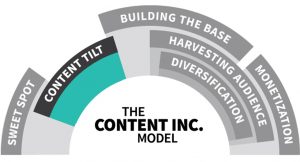It Isn’t Exactly News That Content Is King. Especially On Social Media Where You Have A Noisy Opportunity To Connect With Millions Of People And Conversations — The Keyword Being ‘Noisy’. If You Do What The Rest Of Your Category Or Industry Is Doing, Then Your Content Isn’t Going To Stand Out. But How Do You Approach This Differentiation? The Key Is Using A Content Tilting Strategy.

Building Your Content Marketing Plan
Now, before focusing on what Content Tilting is and how to implement it, it’s important to note that it is just one of six essential steps from Content Marketing Institute’s, Content Inc. Model. However, it is the most crucial step.
“Whether you work in a large, complex enterprise or are a “solopreneur,” one of the biggest mistakes companies make with content marketing is trying to monetize the content before a loyal audience is built,” writes Joe Pulizzi, the founder of Content Marketing Institute. “It takes a plan and patience to build an audience that is more likely to be willing to buy from you.”
The foundation of which is finding your brand’s “sweet spot” — something that will attract an audience over time. But sometimes the sweet spot is not enough. This is where it becomes necessary to “tilt” your content, and gain prominence amongst competitors.
What Is Content Tilting?
Content tilting is what will separate you from everyone else in your market area. The goal of content tilting is to identify the area of little to no competition in your field, capitalizing on it, and maintaining relevance.

Although, a distinguishing factor is not only what makes you different, it’s that is so different that you get noticed by your audience. That audience then rewards you with their attention.
Andrew Davis, the author of Town Inc., calls this “the hook” – an uncomplicated twist on a familiar theme designed to captivate your audience, and occupy their attention. Without framing, or “tilting” your content just enough to truly tell a unique story, your content will fade into the rest of the noisy media environment.
Finding And Setting Your Content Tilt
Somewhere along the line, marketers became captivated with marketing tools, while the unique content these tools were designed to develop took a back seat. However, the combination of these two practices goes hand-in-hand when planning a successful approach to audience building.
After identifying your particular fields of knowledge skill sets intersect with something the business feels is of great value to society, or an inherent value to the target audience, it’s time to start tilting your content.
Remember, your content tilt is what sets you aside from the competition. This means serving unique content to a specific market, with your brand’s angle. The crucial element to this is personalization.
For all of your published content, there must be a uniqueness to your brand’s position. If your core audience senses a familiarity in what you’re publishing, then you may not be tilting your content enough. Be bold with your content’s quality, your message, and brand goals.
An Example Of Content Tilting

Ann Reardon and her Wonder Woman Pop-Art piece made entirely out of chocolate. | Photo from How to Cook That
Ann Reardon, “the baking queen of YouTube,” is an excellent example of how to flaunt your brand’s unique qualities to captivate an audience.
The founder of the How to Cook That YouTube series, Reardon frequently uploads videos with a variety of recipes, instructions, tips, and ideas.
Specializing in unusual recipes, Ann began differentiating herself by making desserts made from five pounds of Snicker’s bars, or cakes made to look like the Instagram logo. Her unique take on traditional baking allowed her to stand out from the thousands of other baking resources on the web.
Testing The Water
Try this exercise from Cultivate Communications. Launch your browser, search for and open your competitor’s blogs in several tabs, as well as your own company blog. Imagine that color schemes and company logos have been removed from all of these web pages. Are you able to tell them apart?
For most industries, the answer is a resounding no.
Producing blog posts, newsletters and other content that looks and reads remarkably is crucial for successful marketing. But if your target audience is unable to differentiate your content from that of your competitors, then it’s time to reevaluate and tilting your content.

